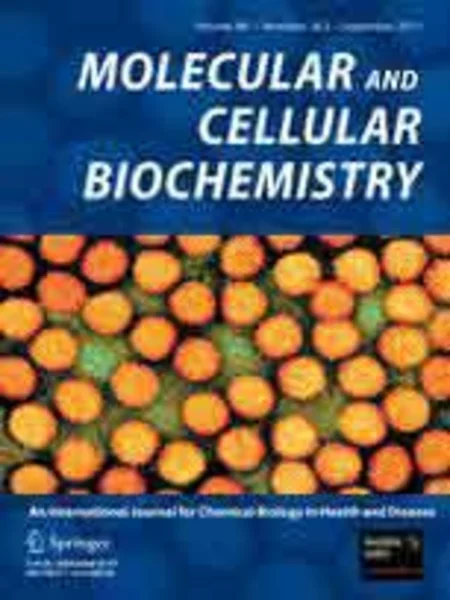-
association of heat-shock proteins in various neurodegenerative disorders: is it a master key to open the therapeutic door?
جزئیات بیشتر مقاله- تاریخ ارائه: 1392/07/24
- تاریخ انتشار در تی پی بین: 1392/07/24
- تعداد بازدید: 1002
- تعداد پرسش و پاسخ ها: 0
- شماره تماس دبیرخانه رویداد: -
a number of acute and chronic neurodegenerative disorders are caused due to misfolding and aggregation of many intra- and extracellular proteins. protein misfolding and aggregation processes in cells are strongly regulated by cellular molecular chaperones known as heat-shock proteins (hsps) that include hsp60, hsp70, hsp40, and hsp90. recent studies have shown the evidences that hsps are colocalized in protein aggregates in alzheimer’s disease (ad), parkinson’s disease (pd), polyglutamine disease (pgd), prion disease, and other neurodegenerative disorders. this fact indicates that hsps might have attempted to prevent aggregate formation in cells and thus to suppress disease conditions. experimental findings have already established in many cases that selective overexpression of hsps like hsp70 and hsp40 prevented the disease progression in various animal models and cellular models. however, recently, various hsp modulators like geldanamycin, 17-(dimethylaminoethylamino)-17-demethoxygeldanamycin, and celastrol have shown to up-regulate the expression level of hsp70 and hsp40, which in turn triggers the solubilization of diseased protein aggregates. hsps are, therefore, if appropriately selected, an attractive choice for therapeutic targeting in various kinds of neurodegeneration and hence are expected to have strong potential as therapeutic agents in suppressing or curing ad, pd, pgd, and other devastative neurodegenerative disorders. in the present review, we report the experimental findings that describe the implication of hsps in the development of neurodegeneration and explore the possibility of how hsps can be used directly or as a target by other agents to prevent various neurodegeneration through preventing aggregation process and thus reducing the toxicity of the oligomers based on the previous reports.
مقالات جدیدترین رویدادها
-
استفاده از تحلیل اهمیت-عملکرد در ارائه الگوی مدیریت خلاقیت سازمانی و ارائه راهکار جهت بهبود
-
بررسی تاثیر ارزش وجوه نقد مازاد بر ساختار سرمایه شرکت های پذیرفته شده در بورس اوراق بهادار تهران
-
بررسی تأثیر سطح افشای ریسک بر قرارداد بدهی شرکت های پذیرفته شده در بورس اوراق بهادار تهران
-
بررسی تأثیر رتبه بندی اعتباری مبتنی بر مدل امتیاز بازار نوظهور بر نقد شوندگی سهام با تأکید بر خصوصی سازی شرکت ها
-
تأثیر آمیخته بازاریابی پوشاک ایرانی بر تصویر ذهنی مشتری پوشاک ایرانی (هاکوپیان)
-
فلسفه ی آموزش علوم
-
رفتار دینامیکی غیرخطی قاب های فولاد مجهز به میراگر فلزی تحت تاثیر زلزله های نزدیک گسل
-
انرژی های زمین شناختی و تعهدات زیست محیطی کارفرمایان (با نگاهی به قراردادهای بالادستی صنعت نفت و گاز ایران)
-
بررسی رابطه شادکامی، امید به زندگی و خلاقیت در دانش آموزان مقطع متوسطه
-
بررسی ارتباط سیستم اطلاعات پرستاری با کاهش استرس کاری پرستاران در بیمارستان های آموزشی زاهدان سال 1393
مقالات جدیدترین ژورنال ها
-
مدیریت و بررسی افسردگی دانش آموزان دختر مقطع متوسطه دوم در دروان کرونا در شهرستان دزفول
-
مدیریت و بررسی خرد سیاسی در اندیشه ی فردوسی در ادب ایران
-
واکاوی و مدیریت توصیفی قلمدان(جاکلیدی)ضریح در موزه آستان قدس رضوی
-
بررسی تاثیر خلاقیت، دانش و انگیزه کارکنان بر پیشنهادات نوآورانه کارکنان ( مورد مطالعه: هتل های 3 و 4 ستاره استان کرمان)
-
بررسی تاثیر کیفیت سیستم های اطلاعاتی بر تصمیم گیری موفق در شرکتهای تولیدی استان اصفهان (مورد مطالعه: مدیران شرکتهای تولیدی استان اصفهان)
-
تاثیر سواد بصری بر مصرف علائم و نشانه های مترو توسط مسافران در زندگی روزمره؛ مورد مطالعاتی: سیستم علائم و نشانه های مترو تهران
-
بررسی حقوقی ایجاب معلق
-
سرمایه اجتماعی گامی به سوی توسعه اجتماعی
-
ارائه راهکارهای پیشگیری و کاهش آسیب در زنان آسیب دیده اجتماعی با تاکید برآموزش
-
آثار قبض و رجوع در عقد هبه از منظر فقه امامیه و حقوق ایران




سوال خود را در مورد این مقاله مطرح نمایید :